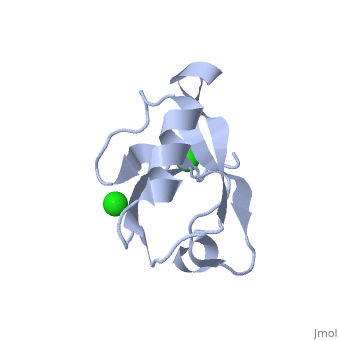2pa1: Difference between revisions
Jump to navigation
Jump to search
No edit summary |
No edit summary |
||
| Line 3: | Line 3: | ||
<StructureSection load='2pa1' size='340' side='right'caption='[[2pa1]], [[Resolution|resolution]] 1.70Å' scene=''> | <StructureSection load='2pa1' size='340' side='right'caption='[[2pa1]], [[Resolution|resolution]] 1.70Å' scene=''> | ||
== Structural highlights == | == Structural highlights == | ||
<table><tr><td colspan='2'>[[2pa1]] is a 1 chain structure with sequence from [https://en.wikipedia.org/wiki/ | <table><tr><td colspan='2'>[[2pa1]] is a 1 chain structure with sequence from [https://en.wikipedia.org/wiki/Homo_sapiens Homo sapiens]. Full crystallographic information is available from [http://oca.weizmann.ac.il/oca-bin/ocashort?id=2PA1 OCA]. For a <b>guided tour on the structure components</b> use [https://proteopedia.org/fgij/fg.htm?mol=2PA1 FirstGlance]. <br> | ||
</td></tr><tr id=' | </td></tr><tr id='method'><td class="sblockLbl"><b>[[Empirical_models|Method:]]</b></td><td class="sblockDat" id="methodDat">X-ray diffraction, [[Resolution|Resolution]] 1.7Å</td></tr> | ||
<tr id=' | <tr id='ligand'><td class="sblockLbl"><b>[[Ligand|Ligands:]]</b></td><td class="sblockDat" id="ligandDat"><scene name='pdbligand=CL:CHLORIDE+ION'>CL</scene></td></tr> | ||
<tr id='resources'><td class="sblockLbl"><b>Resources:</b></td><td class="sblockDat"><span class='plainlinks'>[https://proteopedia.org/fgij/fg.htm?mol=2pa1 FirstGlance], [http://oca.weizmann.ac.il/oca-bin/ocaids?id=2pa1 OCA], [https://pdbe.org/2pa1 PDBe], [https://www.rcsb.org/pdb/explore.do?structureId=2pa1 RCSB], [https://www.ebi.ac.uk/pdbsum/2pa1 PDBsum], [https://prosat.h-its.org/prosat/prosatexe?pdbcode=2pa1 ProSAT]</span></td></tr> | <tr id='resources'><td class="sblockLbl"><b>Resources:</b></td><td class="sblockDat"><span class='plainlinks'>[https://proteopedia.org/fgij/fg.htm?mol=2pa1 FirstGlance], [http://oca.weizmann.ac.il/oca-bin/ocaids?id=2pa1 OCA], [https://pdbe.org/2pa1 PDBe], [https://www.rcsb.org/pdb/explore.do?structureId=2pa1 RCSB], [https://www.ebi.ac.uk/pdbsum/2pa1 PDBsum], [https://prosat.h-its.org/prosat/prosatexe?pdbcode=2pa1 ProSAT]</span></td></tr> | ||
</table> | </table> | ||
== Function == | == Function == | ||
[https://www.uniprot.org/uniprot/PDLI2_HUMAN PDLI2_HUMAN] Probable adapter protein located at the actin cytoskeleton that promotes cell attachment. Necessary for the migratory capacity of epithelial cells. Overexpression enhances cell adhesion to collagen and fibronectin and suppresses anchorage independent growth. May contribute to tumor cell migratory capacity. | |||
== Evolutionary Conservation == | == Evolutionary Conservation == | ||
[[Image:Consurf_key_small.gif|200px|right]] | [[Image:Consurf_key_small.gif|200px|right]] | ||
| Line 20: | Line 20: | ||
</jmol>, as determined by [http://consurfdb.tau.ac.il/ ConSurfDB]. You may read the [[Conservation%2C_Evolutionary|explanation]] of the method and the full data available from [http://bental.tau.ac.il/new_ConSurfDB/main_output.php?pdb_ID=2pa1 ConSurf]. | </jmol>, as determined by [http://consurfdb.tau.ac.il/ ConSurfDB]. You may read the [[Conservation%2C_Evolutionary|explanation]] of the method and the full data available from [http://bental.tau.ac.il/new_ConSurfDB/main_output.php?pdb_ID=2pa1 ConSurf]. | ||
<div style="clear:both"></div> | <div style="clear:both"></div> | ||
==See Also== | ==See Also== | ||
*[[PDZ and LIM domain protein|PDZ and LIM domain protein]] | *[[PDZ and LIM domain protein|PDZ and LIM domain protein]] | ||
__TOC__ | __TOC__ | ||
</StructureSection> | </StructureSection> | ||
[[Category: | [[Category: Homo sapiens]] | ||
[[Category: Large Structures]] | [[Category: Large Structures]] | ||
[[Category: Arrowsmith | [[Category: Arrowsmith CH]] | ||
[[Category: Bunkoczi | [[Category: Bunkoczi G]] | ||
[[Category: Burgess-Brown | [[Category: Burgess-Brown N]] | ||
[[Category: Doyle DA]] | |||
[[Category: Doyle | [[Category: Edwards A]] | ||
[[Category: Edwards | [[Category: Elkins J]] | ||
[[Category: Elkins | [[Category: Papagrigoriou E]] | ||
[[Category: Papagrigoriou | [[Category: Pike ACW]] | ||
[[Category: Pike | [[Category: Salah E]] | ||
[[Category: Shrestha L]] | |||
[[Category: Salah | [[Category: Sundstrom M]] | ||
[[Category: Shrestha | [[Category: Turnbull AP]] | ||
[[Category: Sundstrom | [[Category: Ugochukwu E]] | ||
[[Category: Turnbull | [[Category: Umeano C]] | ||
[[Category: Ugochukwu | [[Category: Uppenberg J]] | ||
[[Category: Umeano | [[Category: Weigelt J]] | ||
[[Category: Uppenberg | [[Category: Von Delft F]] | ||
[[Category: Weigelt | |||
[[Category: | |||
Latest revision as of 12:08, 21 February 2024
Structure of the PDZ domain of human PDLIM2 bound to a C-terminal extension from human beta-tropomyosinStructure of the PDZ domain of human PDLIM2 bound to a C-terminal extension from human beta-tropomyosin
Structural highlights
FunctionPDLI2_HUMAN Probable adapter protein located at the actin cytoskeleton that promotes cell attachment. Necessary for the migratory capacity of epithelial cells. Overexpression enhances cell adhesion to collagen and fibronectin and suppresses anchorage independent growth. May contribute to tumor cell migratory capacity. Evolutionary Conservation Check, as determined by ConSurfDB. You may read the explanation of the method and the full data available from ConSurf. See Also |
| ||||||||||||||||||
